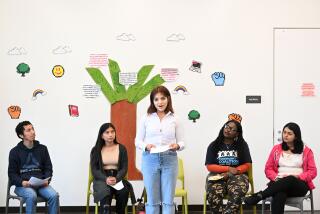Shaya and Class Learn Far More Than Three Rs
- Share via
As most of her third-grade classmates stream out to the playground for recess at Palmyra Elementary School in Orange, third-grader Shaya Van Horn stays behind with four friends.
“I don’t like going outside because there are other people out there I don’t know that stare at me more than my friends,” Shaya says.
Eighteen months ago, the auburn-haired 9-year-old rode her bike, roller-skated, swam, played tag--did all the things little girls do. But almost overnight she fell victim to a rare peripheral nerve disorder that left her paralyzed from the neck down. Since then, she has recovered only partial movement in her right hand and slight movement in her left foot.
Diagnosed with Guillain-Barre syndrome, Shaya is unable to breathe or swallow on her own. A ventilator on the back of her motorized wheelchair is her lifeline, controlling her breathing by delivering a preset number of breaths per minute via tubing connected to her tracheostomy.
A patient at HealthBridge Children’s Rehabilitation Hospital in Orange since moving from her home in Poway in July, Shaya joined the third-grade class in December.
Shaya and another HealthBridge patient--an auto accident victim who attends another elementary school and who also returned to school in December--are two of a growing number of children in the Orange Unified School District and across the nation who have special medical needs. Since 1990, Orange Unified has gone from having 24 such students to more than 300.
Most have less severe medical problems than Shaya--for example, diabetics who need daily blood testing from the school nurse, or students with multiple allergies who may need an Adrenalin injection. But 23 students are considered medically fragile, which means they require one-on-one assistance throughout the school day.
Countywide, of nearly half a million students, 1,445 require special medical procedures and nursing assessment, said Sandy Landry, health and wellness program administrator for the Orange County Department of Education.
Landry said some children need a special school that can deal safely with their multiple, complex needs.
But for those who can be in a regular classroom, Landry said, “that’s the best environment because that’s what they’re going to have to deal with as adults.” And it’s good not only for them, she said, “it’s good for the kids who don’t have disabilities to learn that these kids are bright, articulate and have lots of different kinds of talent.”
Shaya is accompanied throughout the school day by nurse Lisa Ledgerwood, who monitors the ventilator. Occasionally, she must suction saliva from Shaya’s mouth. When deeper suctioning of her trachea is required, Ledgerwood takes Shaya to the school health office, where she also tends to Shaya’s other medical needs.
During class, Ledgerwood, who was hired via outside contract, sits in a chair next to Shaya, who does her schoolwork on a wooden tray placed across her wheelchair. Ledgerwood turns the pages of Shaya’s books and, although Shaya is able to jot down the answers to her math problems and do some writing, she does the more extensive writing for Shaya, who dictates to her.
Although it took her about a month to feel comfortable in class and she still feels self-conscious on the playground, Shaya is now at home in Room 50. Indeed, ask her what she likes best about school and she doesn’t hesitate to answer.
“My friends,” she says, reeling off the names of her eight closest classmates.
It has been a slow progression for Shaya since she was stricken with paralysis.
One morning in October 1999, Shaya called her mother from school in Poway, complaining that she had a headache and didn’t feel well. Julie Van Horn picked up her daughter at 11 a.m. By 3 p.m, Shaya had a temperature and was unsteady when she walked. That continued the next day when Van Horn took Shaya to her pediatrician, who diagnosed the flu and predicted that with rest Shaya would be back to normal in a few days. But she wasn’t. When Shaya awoke the next morning, Van Horn recalls, her daughter could move only her head.
Shaya spent the next seven months at Children’s Hospital of San Diego. Returning home in April 2000, she was able to go back to school in Poway, accompanied by a nurse, for the final month of second grade.
In July, Van Horn moved Shaya into HealthBridge, the closest children’s rehabilitation hospital to their home. She said she had no choice. Unable to find reliable at-home nursing care, particularly on weekends, Van Horn said she would often miss two nights of sleep and, after spending all day by Shaya’s side, she’d be exhausted by Monday morning when she went to work as an administrative assistant for Mail Boxes Etc.
But living 90 miles from her daughter, she acknowledges, “is horrible.”
Van Horn visits Shaya every weekend--from Friday night to Sunday night--and every other Wednesday. “It’s wearing,” she said, “and when Shaya cries and wants her mommy, I can’t be there.”
Getting Shaya back to school was a high priority for Van Horn. “She’s very intelligent and she needed to be in school. I think it’s absolutely vital that children have interaction with other children no matter what their disabilities. Being cooped up in a hospital is so stunting.”
Before a medically fragile child returns to school, a team consisting of the school psychologist, school nurse and special education teacher evaluates the child’s medical and academic situation.
For Shaya, that meant developing a customized health care plan, hiring and training the nurse, communicating with Shaya’s mother and care provider, arranging transportation to and from school, and preparing Shaya’s classmates and teacher for her arrival.
Although Shaya is bright and inquisitive, she was extremely withdrawn her first day back in school, said Van Horn, who accompanied her daughter to class. When she told Shaya she had to leave after half an hour, her daughter pleaded with her not to go.
“I think it took a good month before she started interacting with the other kids,” Van Horn said. “But that was her; not because of them. There were several kids that tried to make contact with her.”
Larry Heim, Shaya’s teacher, said most of the students were “quite reserved” at first around their new classmate.
“They didn’t understand the wheelchair and ventilator,” he said. “It was a little bit overpowering to them, I think. They didn’t understand how delicate her situation is, and I’m not sure all of them do yet.”
But Shaya is definitely part of the class now, he said. “She knows everybody in the room and interacts with them.”
“She’s really nice and fun to be with,” said Catlin Trippanera, 9, who sits near Shaya and showed her around school her first day. “Sometimes when she needs help, I’ll go up and help. Like when we were making Valentines, I cut them out and pasted them for her.”
A recent classroom visit underscored both the fragility of Shaya’s medical condition and the bond that has developed between Shaya and her classmates.
When the bus dropped off Shaya and Ledgerwood at 7:45, classmate Jessica Rodriguez waited to walk with them to class.
Shortly after class started, Shaya required deep suctioning and during the 25 minutes she and Ledgerwood were in the health office, Catlin wrote down in Shaya’s composition book the grammar problems that the class had worked on during her absence.
During morning recess with the four friends Shaya selected to stay inside with her, one girl put a temporary Pokemon tattoo on Shaya’s wrist. And when Shaya asked classmate Eddie Chavez if she could have one of his crackers, he said, “OK” and unhesitatingly placed one in her mouth. Although she is unable to swallow, Shaya can chew and enjoy the taste.
Later, Shaya held her own during the oral multiplication challenge, at one point winning three times-table problems in a row.
“She’s a super student,” Heim said. “Shaya has come a long way fast. She said she didn’t know her times tables when she arrived.”
Shaya attends school half time, from 8 to noon. In the afternoon, a volunteer at HealthBridge usually helps with her homework.
“She’d love to go full time; it’s just not in the cards right now,” said Van Horn. Asked what Shaya’s prognosis is, she said, “How about wait and see? That’s what we get told.”
Jim Lagutaris, director of the cardiopulmonary department at HealthBridge, said that with Guillain-Barre syndrome, “what happens is the neurological function slowly deteriorates in a procession and in the same reverse procession rejuvenates.” That could take as little as three months or as long as two years, he said.
With Shaya, he said, “we really can’t tell at this point if it’s going to reverse itself or not. As time goes on, we get less and less optimistic. However, we remain hopeful.”
Shaya, meanwhile, has school--and her new friends.
Four classmates helped her celebrate her ninth birthday at HealthBridge in January, and she recently attended Catlin’s birthday party at a park. It was, said her mother, Shaya’s first party invitation since becoming ill.
“She cries when she can’t go to school,” Van Horn said. “One day she couldn’t go to school because her nurse was ill and she was mad at her the next day.”
More to Read
Sign up for Essential California
The most important California stories and recommendations in your inbox every morning.
You may occasionally receive promotional content from the Los Angeles Times.













